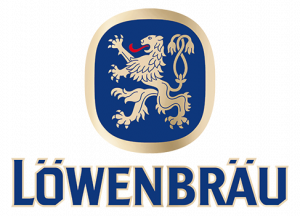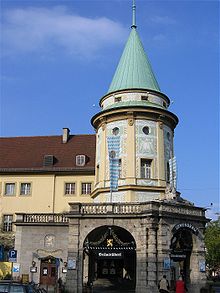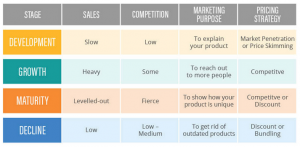33 Löwenbräu

Introduction
Opened in 1690, Löwenbräu (or Lion beer) is a German beer originating in Munich, Bavaria. And is one of six breweries represented at Oktoberfest since only beers brewed in Munich can be sold at the event. (Wikipedia, 2019)

Origins
With rumored origins around 1383, a brewery, located at 17 Löwengrube, was purchased by a man named Georg Brey, a brewer with peasant origins, in 1818. The brewery moved to a new location on Nymphenburger Strasse in 1851 and by 1863, Löwenbräu was producing approximately a quarter of Munich’s beer, making it the largest brewery in the city. (Wikipedia, 2019)
Milestones
After incorporating in 1872 with the name Aktienbrauerei zum Löwenbräu, Ludwig Bery, the brewer and owner at the time, purchased some surrounding properties and, in 1882-1883, ordered the construction of the Löwenbräukeller. The brewery was built by the Rank Brothers, based of the plans by Albert Schmidt, and had its grand opening on June 14th 1883. The lion logo was officially trademarked in 1886 and the brewery eventually became the largest in all of Germany. (Wikipedia, 2019)
In 1921 the company merged with two other breweries, Unionsbräu Schülein & Cie and Munich Bürgerbräu which lead to the acquisition of Bürgerbräukeller, which was a large beer hall located in Munich, Germany. This beer hall would later become noted as the location of the Beer hall Putsch, a failed Coup d’etat, that Adolf Hitler lead against Bavaria, a German state, the capital of which was Munich. A Jewish man named Joseph Schülein eventually became the owner of the company, which lead to Löwenbräu being referred to as “Jewsbeer”, and the eventual allied bombing of the brewery. (Wikipedia, 2019)
SKILL TESTING TIME!
Brewing Science and Industrialization
The industrial revolution was a very significant time not just in human history, but in brewing history as well. This was the time period in which automation and mass production really came to be, beckoning in a new age of civilization. With the rise of new labor laws and regulations came the rise of unions as well. This led to beers popularity rising even farther then what it already was thanks to one new rule: Workers were not allowed to drink distilled spirits while on shift. The workers compromise to this was to switch to drinking beer instead. (Warner, 2010)
At this point, beer was already being bottled, however prior to the industrial boom, the bottles were being hand blown by child workers. With unionization putting a stop to child labor and the demand for beer outweighing the supply of bottling, the industry developed automated bottle blowing and filling, allowing companies to meet the heightened demands, unfortunately another issue began to present itself: Distribution. (American Heroes Channel, 2015)
A man named Adolphus Busch (part of the Anheuser-Busch brewing company, which would eventually own Lowenbrau) in 1876 was at the Philadelphia Centennial fair where he discovered the refrigerated train car. He realized that the refrigerated train cars were ideal at the time for transporting his products nationwide and began to do so immediately. His need for refrigerated train cars was so great, that he wound up starting his own train car company so that he could make and sell the refrigerated train cars instead of buying them. (American Heroes Channel, 2015)
Beer Style
There are two primary classifications of beer; Ales and Lagers. Ales are top fermenting beers that generally have a fruitier and more robust flavor, whereas Lagers are bottom fermenting beers that are matured in cold temperatures for 7-10 days and more thirst quenching and sit lighter in the stomach (Amata, 2014). Lagers are typically yellow pale, amber, or dark in color. Thanks to the invention of refrigeration, the lager style of beer’s population and availability increased immensely. Prior to the invention of refrigeration, brewing lagers was even banned in Germany over the summer months as they could not be Properly fermented. This would have directly affected the brewing of Lowenbrau because of the fact the it was originally brewed in Munich, Bavaria, Germany.

WWI &WWII
In many ways, beer is directly connected to times of war. Quite often it would be provided as rations for soldiers, as it was typically much cleaner than the water available to the front lines. With many of the men who worked in the breweries being sent to fight in the wars, there was a severe lack of manpower in the factories and beer production dropped drastically during World War I (Phillips ,2014).
The war also gave the government the opportunity to enact and enforce restrictions under the guise of reflection wartime conditions. An example would be having to protect grain supplies for bread by limiting drunkenness amongst workers, thus increasing productivity in the factories (Phillips, 2014).
Come World War 2, the situation surrounding beer on the front lines changed. Where there were once restrictions put in place in regard to soldier consuming alcohol, this time around it was much more encouraged. Many of the young soldier had their first beer on the front lines and even advertising was depicting the need for civilians to reduce the amount they drank via rationing, to ensure that the soldiers had enough. (Young, 2019)
Consolidation & Globalization
After the war, many of the smaller brewing companies were unable to maintain production. This gave the largest brewing companies the opportunity to either absorb the smaller companies or purchase brewing rights to be allowed to brew foreign beers on local soil. As shown at the beginning of this chapter, Lowenbrau was no exception. In 1975, Miller Brewing purchased the rights to distribute Lowenbrau on North American soil. They started out by importing the beer from Munich, which lasted for 2 years after which the began brewing domestically with an Americanized recipe.
In 1975 Miller Brewing acquired the North American brewing rights for Löwenbräu, and used the brand to compete with Anheuser-Busch’s Michelob brand. From 1999 to 2002, the North American brewing rights belonged to Labatt Brewing Company, after which exports of Munch Löwenbräu continued to North America. In 2003, Löwenbräu (which merged with Spaten-Franziskaner-Bräu and became Spaten-Löwenbräu-Gruppe in 1997) and was sold to Interbrew, which merged with AmBev in 2004 and became InBev. InBev was then sold to Anheuser- Busch and formed Anheuser-Busch InBev in 2005. Labatt Brewing Company regained the brewing rights in 2014 and began brewing the beer at their London, Ontario Facility.
Modern Era

There are four stages in a products life cycle. They are: Development, Growth, Maturity, and Decline. In the development stage, products tend to have lower levels of sale and competition in the market, advertising typically aimed at explaining what the product is about and is priced lower to get the product on the market (Blakely-Gray, 2017).
In a products growth stage, it has much higher sales with higher levels of competition, a wider range of advertising and more competitive pricing (Blakely-Gray, 2017).
After that comes the maturity stage. In this stage, sales have averaged out and there is much more aggressive competition. Because of this, advertising is more focused on what makes the product unique and different from everything else on the market and has a much more competitive and sometimes even discounted pricing scheme (Blakely-Gray, 2017).
Finally, there is the decline stage. This is normally the end of a products life cycle as sales have dropped, there is much less competition, and the marketing and pricing are much more focused on offloading product with as little loss as possible (Blakely-Gray, 2017).
Based off the aforementioned stages of a products life cycle, Lowenbrau would be considered part of the maturity stage. Depending on whether you are looking at the North American or the Eastern European market, it may lean closer to the decline stage of its life cycle. In North America, consumers prefer more local, domestic products (i.e. Alexander Keith’s, Sleeman, and Molson Canadian in Canada). This has led to Lowenbrau, along with many other foreign beers, having much lower sales and advertising than you would in its native Eastern European market.
As mentioned before, since Lowenbrau is brewed in Munich, Germany, it is qualified to be sold at Oktoberfest; arguably the most popular beer festival in the world. With it being only one of six beers sold at the fest, and with being sold there every year since 1810, the beer is much more popular (Wikipedia, 2019). Since Lowenbrau is in such exclusive company during Oktoberfest, the competition between the six companies would be much more aggressive, however this also means that the requirement for any major advertising would be much lower.
References
Wikipedia contributors. (2019, July 1). Löwenbräu Brewery. In Wikipedia, The Free Encyclopedia. Retrieved 03:11, September 29, 2019, from https://en.wikipedia.org/w/index.php?title=L%C3%B6wenbr%C3%A4u_Brewery&oldid=904310857
American Heroes Channel. (2015, March 4th). Getting Cold Beer to the Masses Drives Sweeping Innovations [Video File]. Retrieved from: https://www.youtube.com/watch?v=MJSKdUzVV5Y&t=1s
Warner, A. G. (2010). The evolution of the American brewing industry. Journal of Business Case Studies (JBCS), 6(6).
Prud’homme Beer Certification and Amata, M. (2014). Beerology. Random House.
Paul Young. (2019, Feb 3rd). WWII Beer Final [Video File]. Retrieved from:
https://www.youtube.com/watch?time_continue=229&v=-h3EDnspynQ&feature=emb_logo
Blakely-Gray, R. (2017, August 22). What Is the Product Life Cycle, and How Does it Impact Pricing Strategies. Retrieved from: http://www.patriotsoftware.com/accounting/training/blog/what-is-product-life-cycle-management/

